Seeking a job as a creative, you’ll eventually have to create a portfolio. For juniors and seniors alike, a professional online portfolio gives you your best bet at making a strong first impression. In fact, a lot more depends on it than on your resume, for an obvious reason: It goes beyond listing your skills by showcasing them. You can put anything into your CV, but putting those skills into practice – what recruiters are looking for – makes for a different story. This quick guide will reveal how to make a portfolio which showcases you as a professional.
When the pressure hits, you have to make many decisions when it comes to building a portfolio. So we usually procrastinate this task until the very last minute. Still, submitting a sloppy portfolio doesn’t come into question for anyone who wants to make it in design. For that reason, we’ve created this six-step checklist on creating a portfolio online, guiding you through the most important steps and saving you lots of time:
- What platform to choose
- How to filter your work
- Where to collect honest feedback
- How to use your competition to your own advantage
- How to keep it fresh
- Reasons to focus on the process and methodology
1. Choose a platform
Comparing, reading about and testing the dozens of hosting and portfolio services out there can easily take you down the rabbithole. Sadly, this still leaves you procrastinating, though it might seem like working on your portfolio. After all, it all comes down to:
- Portfolio builder tools,
- Website builders and
- Self-hosted websites.
Consider two important factors when choosing the ideal platform: time and skills. Do you have the time to code a portfolio website? Do you know how to make a portfolio from scratch? Can you keep it up-to-date once you’ve finished?
If you answer yes to all of those, by all means build your own portfolio. Otherwise, choose a platform such as UXfolio to save time and build something impressive. Do it without the hassle of hosting, coding, plugins and whatnot.
2. Filter and curate only the most compelling projects
Make “less means more” your mantra when working on your portfolio. We form attachments to our projects, even if we don’t like them in the beginning. Hence, curating your own work can prove the hardest step in portfolio building. Still, you can’t get around this – you’ll have to kill your darlings. Recruiters don’t have time to scroll through all your projects and search for the best. Do it for them. Curating your own work lets you keep control of your image.
Choosing the best
But what to consider the best? In this scenario, look for the work that highlights most of your professional and soft skills as well. Presenting yourself as a machine that just happens to end up with perfect products makes you look alienating and standoffish. Instead, showcase the projects you learned from, projects that made you effectively change trajectory.
Showcasing your skills
To showcase a wider variety of skills, ask yourself: “Which of my finished projects were the most problematic?” You still managed to finish them – any employer’s dream. Think of the lists of personal and soft skills on your CV. Your portfolio displays them best.
Signal your strengths
Two routes can communicate your forte in your portfolio. The first: Pick your niche. Presenting yourself as a jack of all trades comes with risks as you might come off as a master of none. Which of your works represent your taste, interest and passion the best? That work represents your niche, what makes you stand out.
The other route focuses on the organization you are targeting with your portfolio. If you already have a potential employer in mind, choose the work closest to their world and most likely to sway them in your favor. With UXfolio Premium, you can categorize your work into different portfolios and send them out selectively.
Either of these approaches will put another a filter on your material. That puts you one step closer to achieving your goal.
Those who are just starting out
Blank canvases have some incredible perks. First, you can choose your own path. Think of the industry that interests you most, and create some targeted mock projects that show off your dedication and enthusiasm. Employers find it hard to resist someone who displays passion and enthusiasm. Also, a career portfolio with one mock project looks better than nothing at all.
3. Collect honest opinions for improvement
Not even your friends who “always keep it real” will tell you how awful they find the work you gush over. Rely on strangers’ opinions, especially if they come from the crowd you want to join. This will help your decisions when whittling down and improving your work. Also, to toot our own horn, UXfolio has two review features:
- Community reviews
- Expert reviews
Community portfolio reviews
As part of our community, you can ask for peer reviews on your projects. This feature lets users give back. If you give feedback to others, you’ll get Karma Points. Use them to request reviews on your own projects. We include this option in all our plans – free, standard and premium. The best thing: You can get honest opinions and learn a lot by giving yours and helping others (more on this in point 3).
Expert reviews
Our Premium Users have the option to ask for expert reviews. Since our team of portfolio experts has seen an incredible number of portfolios, they know what to improve and what to leave untouched. With it, you can push any of your projects to the next level.
Alternatives
Alternatively, you can post your portfolio to various Facebook groups or subreddits and ask for feedback.
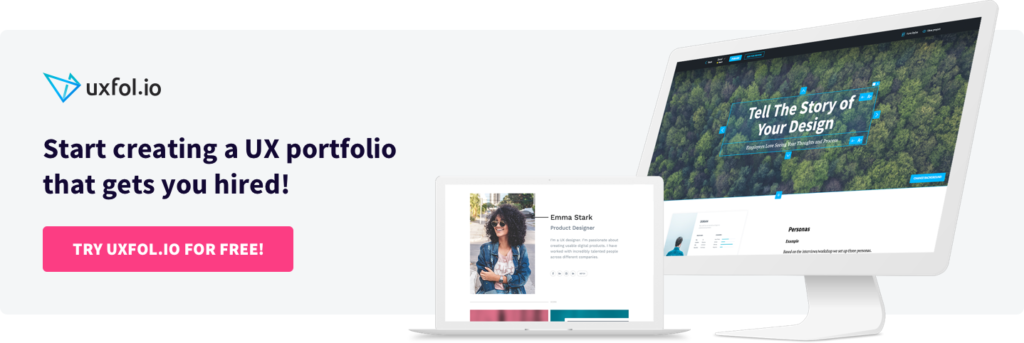
4. Check out the competition and success stories
The more work you check out and the more impressions you collect, the more you’ll learn about your own. Through observing others, we discover the strengths and weaknesses of our material. Check out some of the best professional portfolios for inspiration. Looking at the good and the bad will give you momentum to work on your own stuff.
5. Keep it fresh
In digital, a lot can change in a day, let alone a year. You might want to think twice about the freshness of the projects you include in your portfolio. This does not mean you can’t include older projects. Instead, just find the right way to present them. You might want to indicate what you’d do differently today. Maybe add an extra section with notes that shows your awareness of current happenings.
Update your past projects
When it comes to digital content – whether your portfolio or blog – we can never consider things “done”. A fresh eye will reveal mistakes or awkwardness. Once you took a few steps back, revisit your portfolio. Maybe change a picture, clarify a research method, restructure a sentence, or add or take a few sections. With a tool like UXfolio, you have all the flexibility that you need. Eventually, it will turn into the masterpiece that it is destined to be.
The same applies after you land a job. Do you delete your LinkedIn profile? Of course not! Then why delete your portfolio? Keep it organized and maybe update it sometimes. When a client researches you, Google’s first page should show your portfolio instead of 200 Facebook profiles with a name similar to yours.
6. Showcase your process and methodology
As mentioned in the first point, you have to highlight the process and methodology you used throughout the project. Point out how you tackled the challenges of a project. What methodology did you use and why? A project worthy of your portfolio will give you many opportunities. It will also add background to your decisions throughout the project and showcase your expertise.
Collect your drafts
Think about the future. You never know when you’ll need your portfolio. So, keep unpublished drafts in your UXfolio profile with some notes and insights. You can always go back, edit them a bit and publish them in your public portfolio. Consider it a binder full of potential material!
How to make a portfolio with UXfolio
After you have a UXfolio account and you have gathered a neat list of projects, it is time to take advantage of all the features we offer. Let’s begin!
1. Pick a stunning template

This will be the easiest part, as all UXfolio templates are stunning. 😉 Just choose the one that grabs your attention or the one that is closest to your taste. Another option is that you can take a strategic approach: if you don’t have too many projects to showcase, you should try a template that focuses on your profile details, so the lack of projects is not too obvious.
2. Add a photo, bio, social links, and resumé
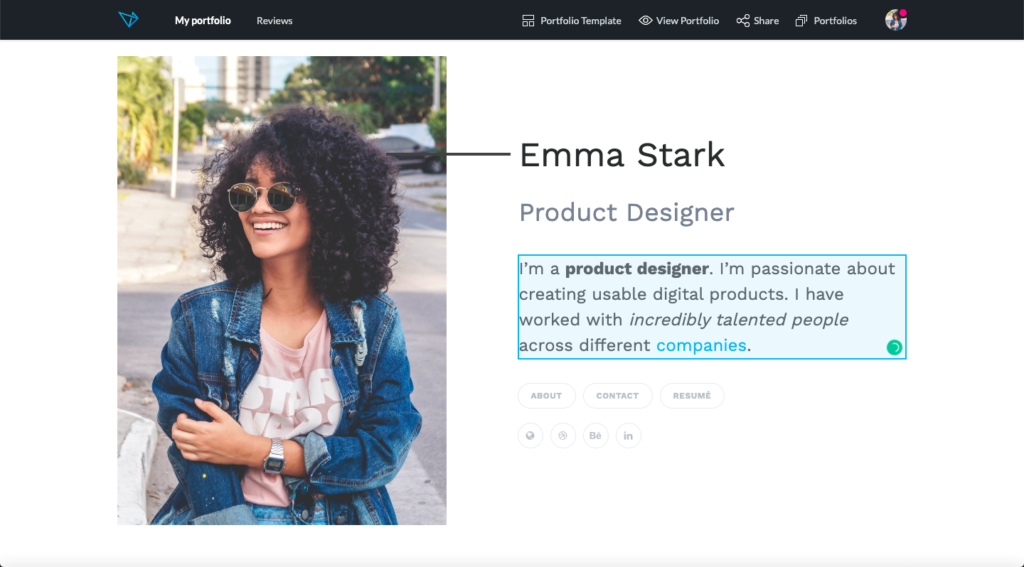
After your UXfolio account is up, get the basics out of the way: fill out the necessary profile information so you can start working on the good stuff. We suggest you let your work speak for itself and spend your time with projects instead of your ‘About’ page. However, if you have a few extra minutes, it doesn’t hurt to put some more effort into your bio. Also, upload your UX designer resume to make the HR professionals’ job easier.
3. Make your job easier
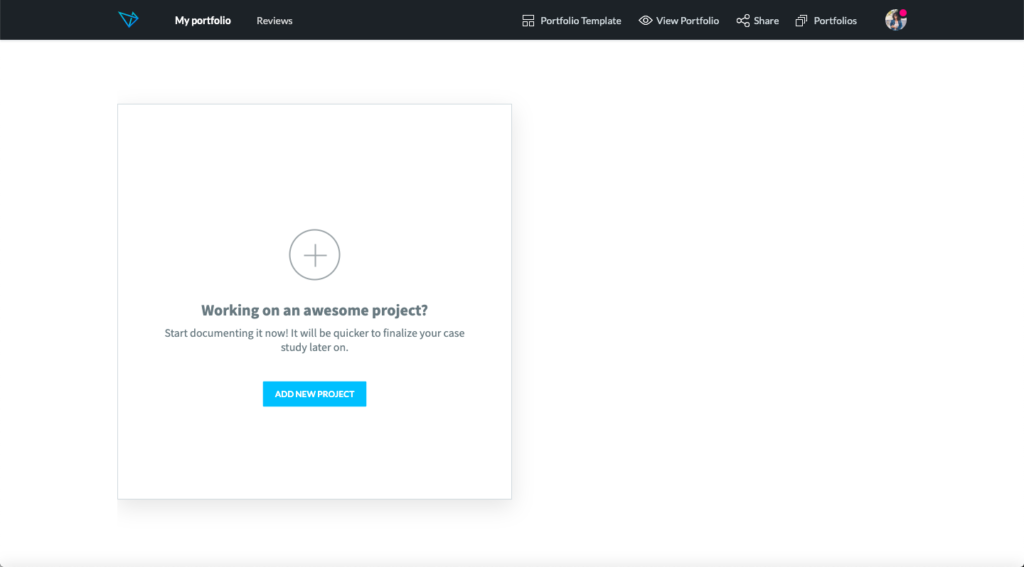
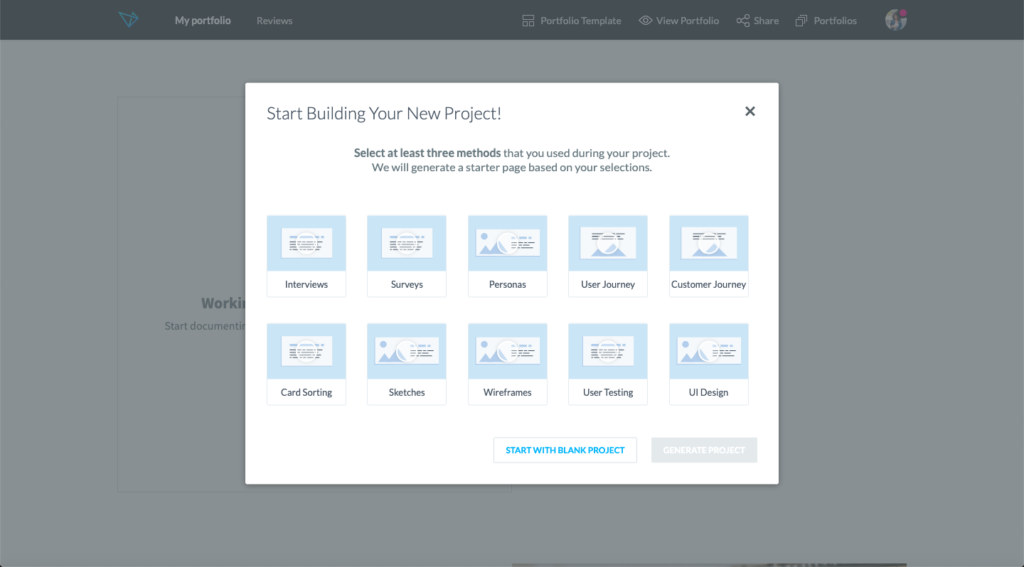
Our goal is to make portfolio creation a simple, but comprehensive process. Therefore, we can generate you a starter template based on the methodologies that you have used through a project. When ‘Add a New Project’ you will be offered several options to choose from, but you can also ‘Start with a Blank Project’.
4. Focus on the projects
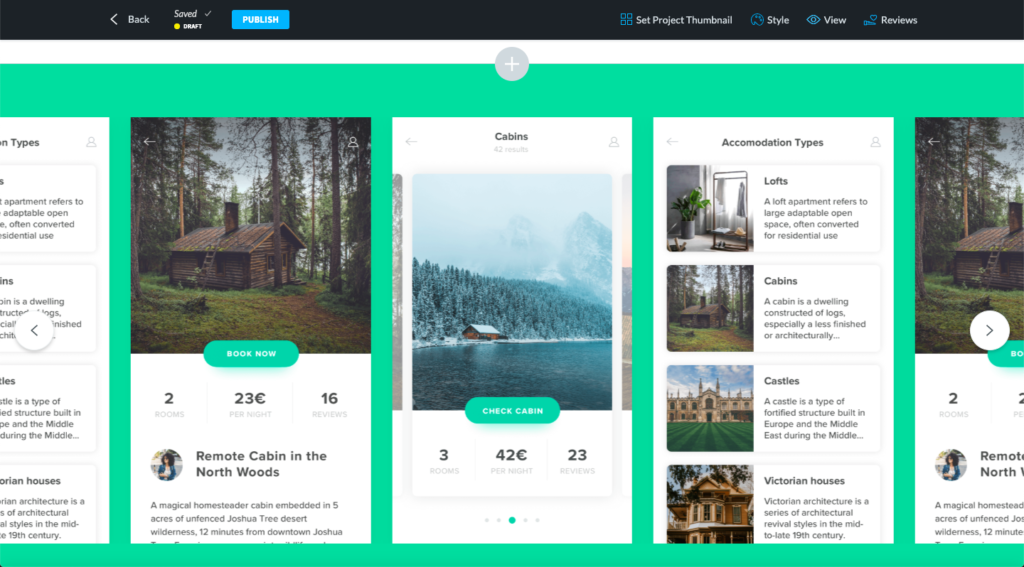
This is the point where you can fill up the project with all the information that highlights your skills and abilities. Use most of your time and effort here. The more details you add, the higher your chance is to catch the recruiters’ attention. UXfolio will help you with personalization options and guiding questions. Your project will be auto-saved as a draft while you are working on it.
5. Create different portfolios
As a Premium Subscriber, you can sort your published projects into different portfolios. You can send out each to different employers. This makes curation an easier process if you have more projects. As a Standard or Free Subscriber, you can have one portfolio only.
6. Always double-check
Before sending out your portfolio, double-check how it looks and whether it is what you want to be seen on the other side. You can easily do this by clicking on the ‘View Portfolio’ button in the header.
With UXfolio you can start it right away.
We created our product, UXfolio to support both junior and senior UX professionals with portfolio building. It generates you your portfolio website, a stunning front page, and it helps you put together nice project case studies in minutes.
It helps you in the copywriting part with great examples and guiding questions. And you can even ask for detailed reviews on your case studies before applying for your next job.
Set up an impressive UX portfolio simply and quickly with UXfolio.
Click here to sign up and try it out!